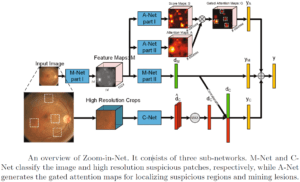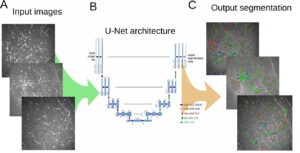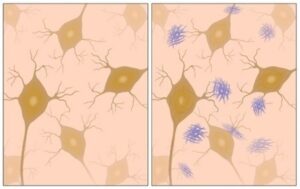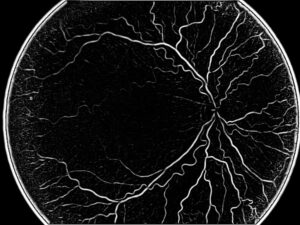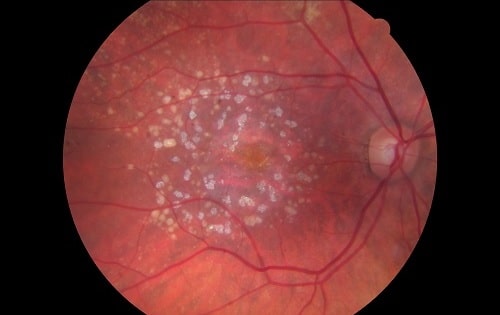
Different imaging methods are used: among them, IR imaging, FAF (fundus autofluorescence), regular fundus images and OCT. Having images coming from all these modalities is the ideal solution, however each one of them can provide good enough pictures to assess the situation.
Geographic Atrophy Segmentation
The problem in estimating the size of the GA is that in many cases the boundaries are not very clear. When boundaries are clear, we can use the segmentation methods which are well known in the literature, specifically adjusted as fit for retina analysis. Nevertheless, difficulties are to be expected when the contours of the GA are not so clear-cut, at the three levels: the background of the eye (which can be quite dark); the GA itself, represented by a clear area; and the parts in between, who can also be quite dark, with no certainty whether they belong to the GA or not.
Software has to deal with all these challenges. When the boundaries are clear, all is good. But when boundaries are not clear enough, the results are not sufficient for giving sufficient information to the ophthalmologist whether the area belongs or not to GA. Human evaluation in this task is subject to high inter-observer and intra-observer variation, associating different areas to the Geographic Atrophy at each observation, which makes less reliable the observation of changes over time.
Segmentation in the medical field relies often on the following algorithmic techniques: first and foremost region growing, which in many cases is nearly intuitive and quite easy to find: the darkest point will be associated to GA, within which a seed will be identified and grown until they reach the pixels belonging to the retina itself. Another technique is segmentation based on Otsu, a method designed to find the best separation between two populations, based on the histogram; in this approach, we take the threshold that leaves minimal variance to the two separate groups. One more technique is graph-cuts, which enable to balance segmentation between proximity of the pixels and their gray level. This algorithm is based on the graph theory, finding the minimal cut in a flow graph. Used in image processing, this technology cuts between two levels: source (in this case, the area within the GA) and sink (the retina itself). Its mission is to find the best cut separating the pixels of the source and background.
The seed to be used in region growing can be selected either by human expert or by the machine: when the image is very clear and the Geographic Atrophy has clear boundaries, we can let the algorithms detect the seed without any input by the ophthalmologist. On more ambiguous images, it’s recommended to let the physician control this process.
RSIP Vision has a rich experience in developing algorithmic solutions for many technology companies in the field of ophthalmology. Take advantage of our experience and consult our engineers before starting your project.

 Ophthalmology
Ophthalmology
